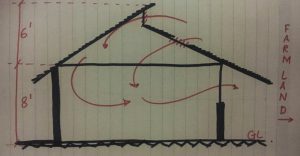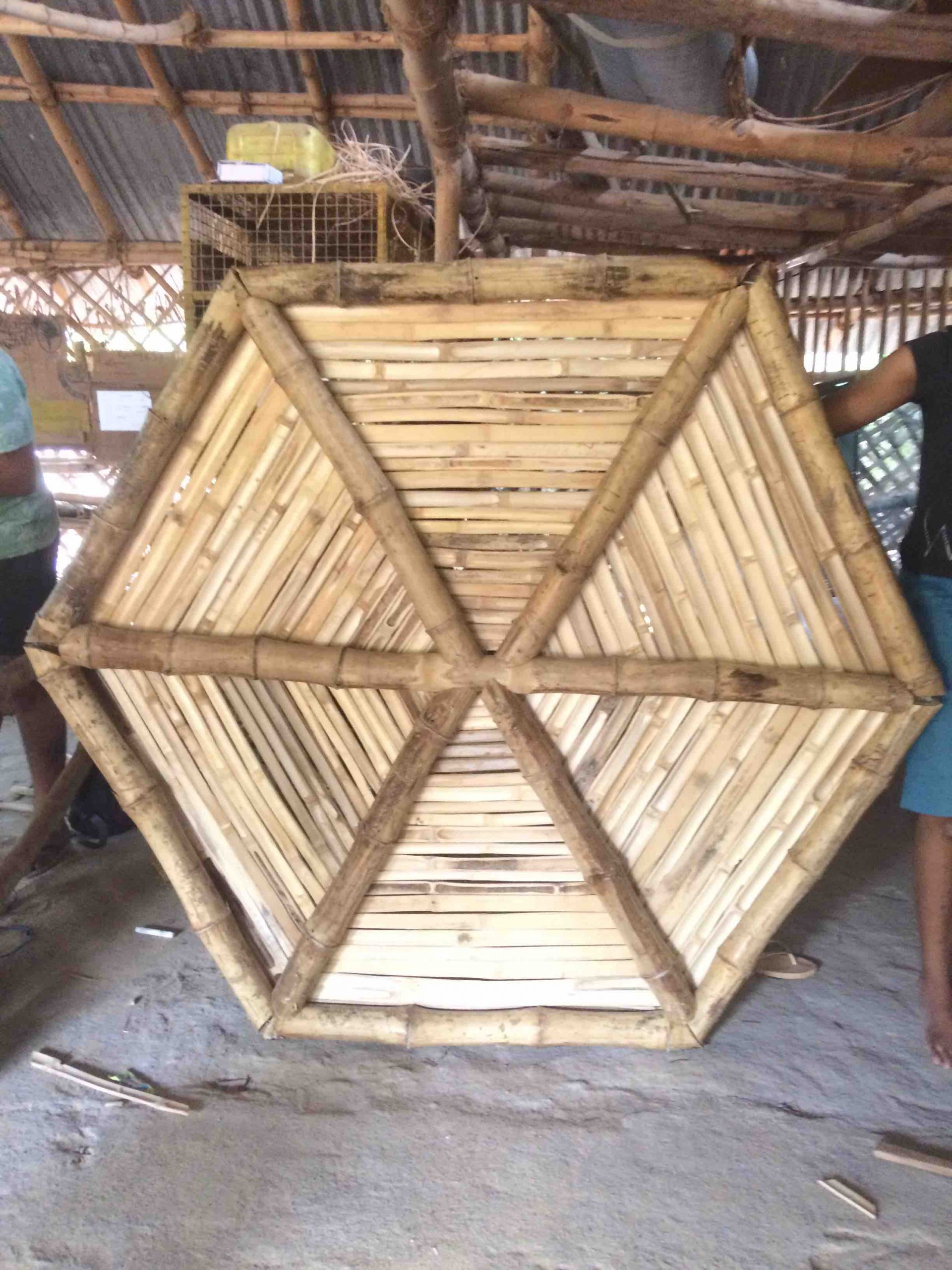Priyamvadha

I, M.Priyamvadha Mohan, an architecture student doing IV th year internship
at Auroville Bamboo Centre, Auroville.
“we shape our buildings/society and then the vice versa”
email: priyamvadhamohan1123@gmail.com
SRISTI’S VILLAGE FOUNDATION BY M.PRIYAMVADHA
DESIGN BRIEF:
Ø To design and construct a mushroom cultivation hut on the site of 15 x 20 ft.
Ø The micro climate inside the building should be maintained at 25 to 30 degree lower than the outside temperature.
Ø Basement made of concrete will be 2 ft below the ground level with a top layer of river sand which will be kept wet constantly to maintain temperature.
Ø The walls will be built only till sill level above which a special agricultural fabric will be used for walls, the mushroom is grown in bags.
Ø The roof structure can be independent of the plinth with large overhang to protect the walls from direct sunlight.
Ø Roofing material will be thatch, which helps in insulation.
Ø Static structure for the room and columns will be built with bamboo.
Ø Plinth will be built with mud, cement and stone.
Ø Column foundation will be a simple concrete footing.
Ø Wall will be bamboo reinforced mud wall.
Ø Mushroom bags that will be hanged on the beams.
Ø The weight of the one mushroom bag will be ranging from 2.5 to 3 kg and three mushroom bags will be hanged together.
DESIGN PROCESS:
PLANNING:
The main idea is to utilize the space in such a way that maximum number of mushroom bags could be used. Also, to minimize the load on the beam as mushroom bags already takes more load. Hence, a column of three bamboo poles is used for support.
The students from Switzerland came up with two design ideas:
1.THE ARCH ROOFED
The arch roof is separated from the main structure so that the load on the roof could be transferred separately. But, the disadvantage is the arch takes a lot of time to make and it has to be prefabricated.
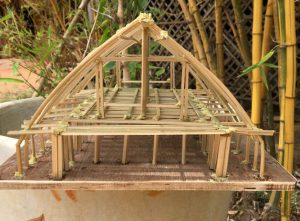
2.THE PITCH ROOFED
In this type, the roof is not separated from the main structure but the beams are extended for 1 ft on both sides for ventilation. The roof height is equal on all the sides. Hence, it is difficult to channel the air.
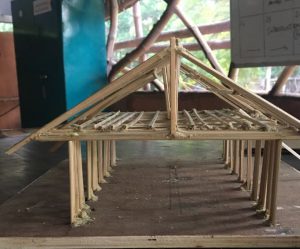
The design consists of 14 columns with the span of 2ft and the beams that are placed on the top of every column. In between two beams, there are two more secondary beams coming up for hanging the mushroom bags.

BASE PLAN
The number of columns and beams seemed to be more as also it takes so much load and the material. Hence, the team and the architect concluded the number of columns as 5 with 3 bamboo poles and a beam on the top.
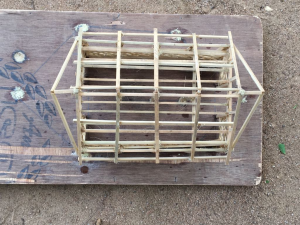
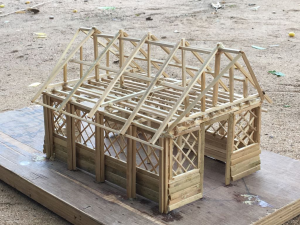
The roof design is kept open for the students. The number and placement of columns and beams is fixed.
After the arrival of the students, the roof is designed again and is fixed after checking the stability with a physical model.
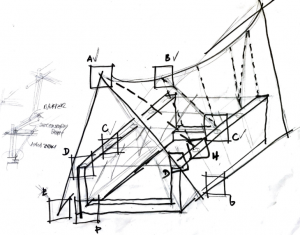
PHYSICAL MODEL:
MATERIAL ESTIMATION:
CONSTRUCTION PROCESS:
FOUNDATION:
The foundation pit that is digged for 1.5 ft and plastic barrels that are used as footing. Inside the barrel, a mixture of Blue metal stone +
Gravel sand + Cement is filled. The three bamboos of diameter 3.5 inches are tied together and inserted inside the barrel that consist of a concrete mixture in ratio 1:2:4. Only half of the barrel that is 1 ft is buried under the ground where the remaining 1ft is left exposed.
FOUNDATION DETAIL:
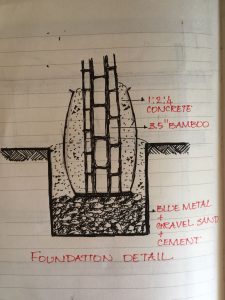
COLUMNS:
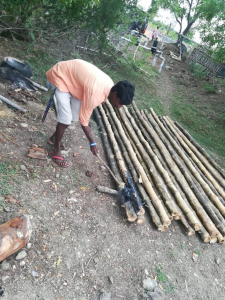
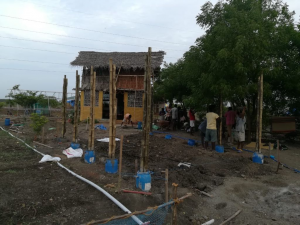
The column that consist of 3 bamboo poles are coated with tar, joined together with bamboo pins and placed in such a way that the beams are held firmly and transfers maximum load.
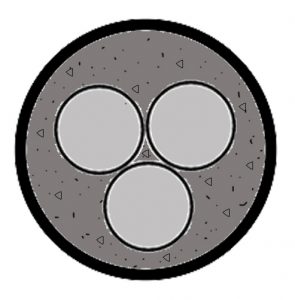
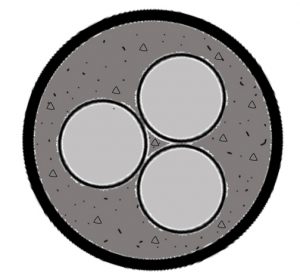
AT CORNERS AT SIDES
SPECIFICATIONS
Height of the column – 8 ft
Diameter of the bamboo – 3.5 inches
Total thickness of the column – 7 inches
Width of the barrel – 11 inches
Total span – 20 ft
Span between columns – 5 ft
Total no. of columns – 10
COLUMN PLACEMENT PLAN

BEAMS:
The beams are supported on three bamboo poles as all the poles take equal loads. They are bolted from all the sides and tied together with coconut ropes. The height of one pole is raised. Hence, it holds all the primary beams firmly. Secondary beams are placed on the top of primary beams with two bamboo poles for hanging the mushroom bags. Finally all of them are bolted and tied together.
An extra support from the column to beam is given to transfer the load.
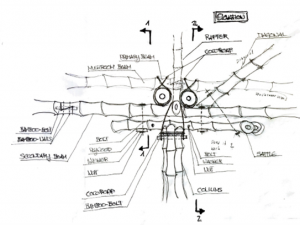
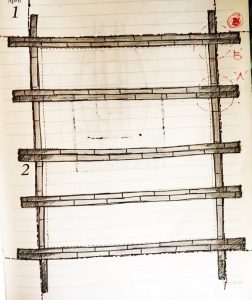
WALL:
Double course brick wall of thickness 7.5 inches is constructed for the height of 3 ft with no cement plastering.
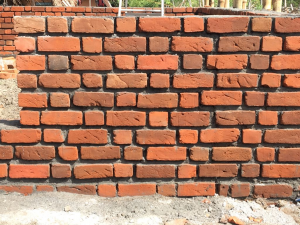
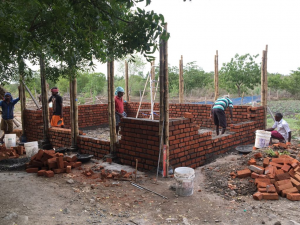
WALL PANELING:
The wall paneling is done from the level 3 – 8 ft where the bamboo splits are used, creating a pattern on all the four sides. A frame with bamboo splits is made and the splits are placed diagonally with 3 – 3.5 inches span. This helps in ventilation of the structure that it creates good air flow on all the sides.

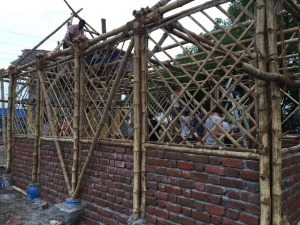
ROOF:
The roof is designed in such a way that maximum amount of air could be channeled into the building. Large opening on the north-west side with louvers to capture the wind. The opening is tied with a fabric and it is kept wet all the time. Hence, the air that enters the building would be cool.
Height of the opening on NW – 12 ft
Height of the opening on SE – 8 ft
Height at the middle – 6 ft
Height of the opening on NW – 12 ft
Height of the opening on SE – 8 ft
Height at the middle – 6 ft


The total number of A-frames used in the structure are 20 with the span of 1 ft in between. Two diagonal A-frames that supports top of the roof to the beam.
The TENSION BEAM which is of length 30 ft is joined from one corner to the other. This is flexible as it was made by tying several bamboo splits together with coconut rope and coated with tar. This tension beam transfers the load on the roof to the beams and columns.
PURLINS that connects all the A-frames together on different levels.
Thatch roof is done for the roofing as it keeps the building cool.
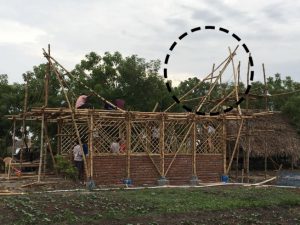 .
. 
DIAGONAL A-FRAME TENSION BEAM

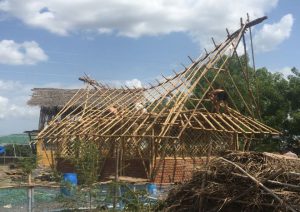
RAFTERS PURLINS
FAÇADE:
Front façade that allows the air to get channeled and also gives a good elevation. 2 ft bamboo poles are used for the façade.
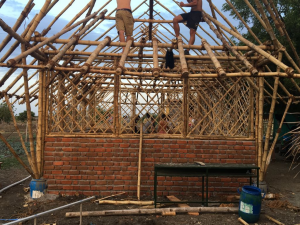
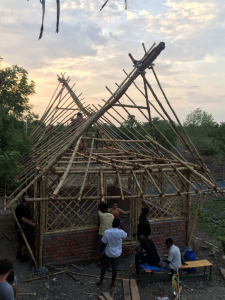
JOINERY DETAILS:
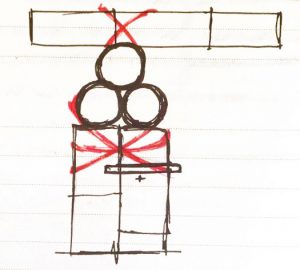

DETAIL “A” DETAIL “B”

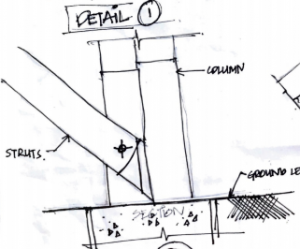


PHOTOGRAPHS:
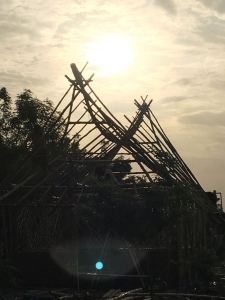
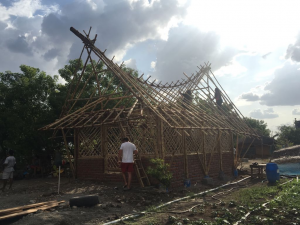

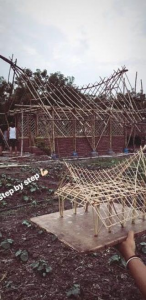


RESULT:
As the context of the building didn’t suite the requirement and the roof design is innovative, the building is used as a dormitory/ resting place for the workers. Here the roof part is also used as the next level.
PROPOSAL FOR THE MUSHROOM HUT:
Ø Louvers that receives the wind from the NW and circulates inside the building.
Ø Brick wall of height 8 ft on one side and the other with the height of 3 ft.
Ø Opening with bamboo splits from the level 3 – 8ft.
Ø The air that is taken in by the louvers will be sent out through the opening.
Ø The opening is given on the NW as it has a farm land on the right so, the amount of air that is received will be more when compared to any other sides.
Ø Roof height is decreased as there no function on the top.
